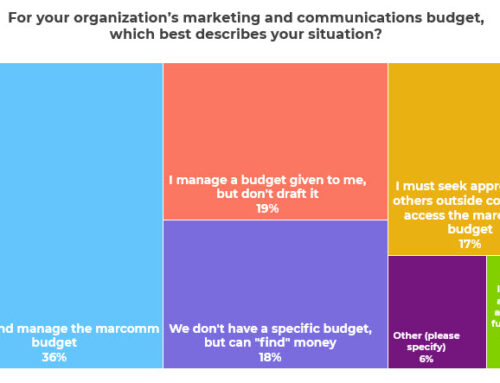 It’s my least favorite goal for nonprofit communicators: Brand Awareness. Why? Because it’s vague and hard to measure, and therefore hard to know what will really work best to increase it.
It’s my least favorite goal for nonprofit communicators: Brand Awareness. Why? Because it’s vague and hard to measure, and therefore hard to know what will really work best to increase it.
Nevertheless, raising brand awareness is a top goal for many nonprofit communications departments, according to our research. The argument for the goal goes like this: If someone isn’t aware you exist, then how can they use your services, get educated on issues, advocate for your cause, volunteer to help, or donate financial support? Awareness that you exist comes first (at least in theory — often times a compelling call to action or opportunity actually comes before organizational awareness).
It’s much easier to establish a realistic awareness raising goal and to measure your progress if you pick from that long list of what traditionally comes after awareness. For example, what kinds of awareness-raising activities lead to more volunteers? That’s likely a different set of communications tactics that the awareness-raising activities that lead to more users of your services. You can set SMART goals for these (Specific, Measurable, Achievable, Results-Oriented, and Time-Bound).
But what if your organizational leaders won’t get that specific with you, and insist on you working on “awareness” more broadly?
For organizations willing to invest big dollars in public surveying, you can get some answers. Big Duck is trying to make this expensive research more affordable for nonprofits with their collaborative Brandraising Benchmark. But that still costs $2,200.
So what’s a communications director with broad awareness goals but without a budget to do?
I suggest you focus first on the size of your permission-based lists. If someone is on your mailing list or follows you on social media, they are aware of you, as long as they put themselves on those lists. Of course, just building a list for the sake of those numbers isn’t enough. You do need to couple list growth with engagement metrics so that you are building a high-quality list of the right kinds of people. But list size is one legitimate way to measure awareness.
Next, look at traffic metrics that bring people to those various opt-in/following opportunities. For example, is your website traffic growing? Are people regularly sharing your content on social media?
Finally, consider a way to measure mentions or how “top of mind” your organization is. This is much easier to do with a paid analytics tool that tracks online conversations and your share in them. But even without these tools, you can use anecdotal examples to help show how you are raising awareness. Do you see others recommending your organization online? Did someone prominent mention you? Do you get a lot of referrals from other sources? Are you getting media calls or coverage?
We’ll talk more about strategic and affordable ways to measure your communications effectiveness during our two webinars next week.





